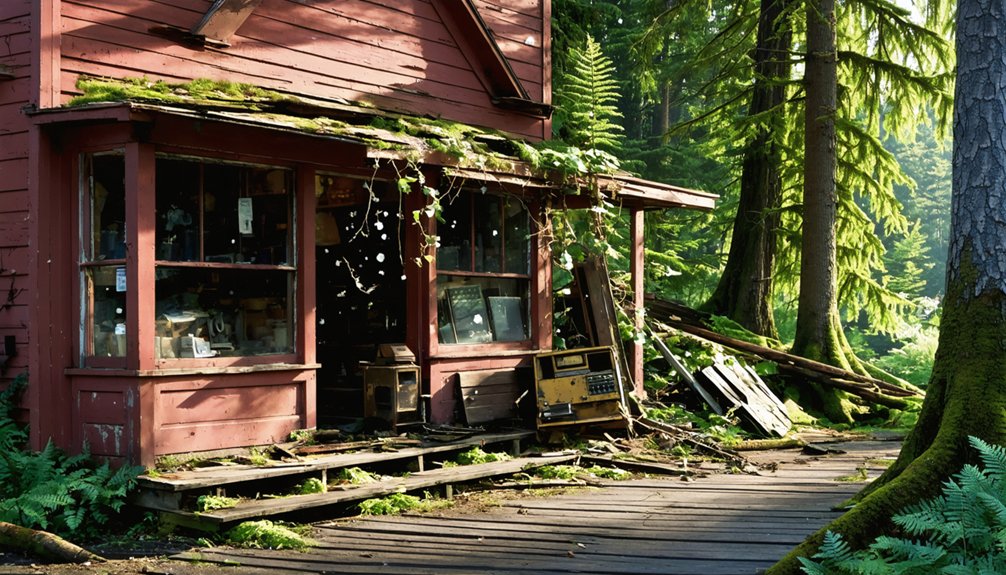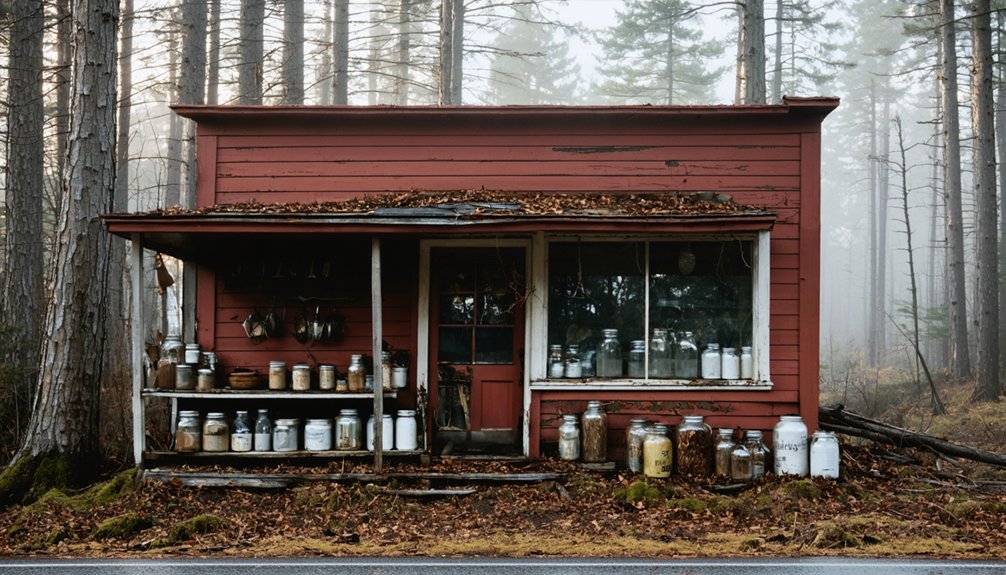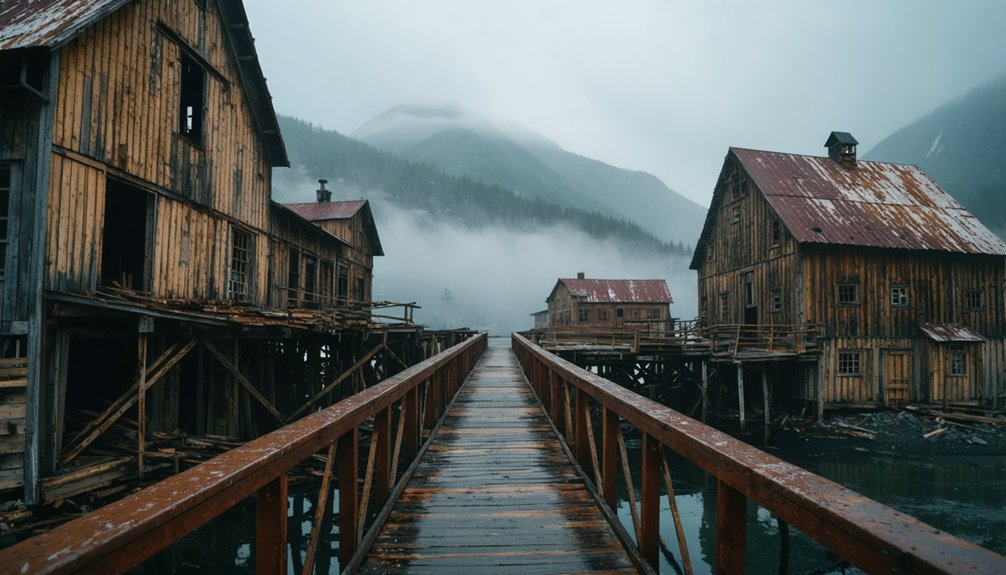Abandoned timber towns dot America’s landscape as poignant demonstrations to the boom-and-bust cycle of the logging industry. You’ll find these forgotten communities from Maine to California, where weathered wooden structures and crumbling mills reveal their once-prosperous past. Economic collapse came swiftly when forests depleted or regulations changed, leaving behind architectural remnants now reclaimed by nature. These ghost towns preserve a vital chapter of American industrial heritage waiting to be uncovered.
Key Takeaways
- Once-thriving timber towns now exist as archaeological sites after economic collapse due to resource depletion and industry mechanization.
- Communities faced unemployment rates exceeding 20% and high housing abandonment when timber operations ceased.
- Architectural remnants like wooden structures and mill foundations showcase period-specific construction techniques amid natural reclamation.
- Historical societies and preservation initiatives document and restore timber heritage sites as educational centers across America.
- Former timber towns illustrate both environmental consequences of resource exploitation and opportunities for adaptive reuse as cultural spaces.
The Rise and Fall of America’s Logging Communities
As the American frontier expanded westward through uncharted wilderness, the timber industry emerged as both a catalyst for settlement and an economic powerhouse that would transform the landscape of a young nation.
You’d have witnessed remarkable logging innovations propel these communities forward—from rudimentary pit-sawing to water-powered mills and eventually steam-driven operations that accelerated production exponentially.
These towns flourished where resources converged: virgin forests, transportation networks, and labor. The timber trade created bustling communities overnight, with Bangor, Maine processing an astonishing 8.7 trillion board feet by century’s end. The invention of the circular saw revolutionized lumber production and dramatically increased the output of sawmills throughout the expanding nation. The American Tree Farm System began in 1941 when the first tree farm was dedicated in Montesano, Washington, marking a shift toward sustainable forestry practices.
At the nexus of forests, railways and willing hands, timber towns erupted from wilderness into economic powerhouses.
Yet prosperity carried the seeds of decline. As forests disappeared beneath the sawyers’ blades, towns faced inevitable abandonment. The very wealth that built these communities—timber—would eventually vanish, leaving behind only memories and decaying structures reclaimed by nature.
Elkmont: From Bustling Timber Hub to Ghost Town
Deep within the forested valleys of Tennessee’s Great Smoky Mountains, Elkmont stands as a poignant reminder to the fleeting nature of resource-driven prosperity.
Once a thriving company town where the Little River Lumber Company harvested poplar and hemlock, Elkmont history follows a classic boom-and-bust trajectory. By 1918, over 1,500 residents called this railroad-connected settlement home.
You’ll find Elkmont’s transformation particularly fascinating—when timber resources depleted by 1926, wealthy families from Knoxville had already begun establishing vacation retreats.
Elkmont tourism supplanted logging as residents traded sawmills for summer cottages. The establishment of Great Smoky Mountains National Park in 1934 ultimately sealed its fate. The area’s unique set-off houses could be dismantled and relocated as logging operations moved to new areas.
The iconic Little River Railroad built by Townsend revolutionized timber transportation throughout the region, moving logs more efficiently than ever before.
Today, you can wander among approximately 70 decaying structures—silent witnesses to America’s complicated relationship with natural resources and the freedom of reinvention.
How Environmental Conservation Transformed Logging Settlements
While abandoned timber towns dotted America’s landscape as somber reminders of resource depletion, environmental conservation emerged as a powerful transformative force that redefined these communities’ purposes and identities.
You’ll find places like Darrington, Washington, where community-based forest restoration initiatives integrate conservation with local livelihoods, preserving both ecological integrity and cultural heritage.
The shift wasn’t simple—regulatory measures like the Adirondacks’ “Forever Wild” clause of 1883 initially restricted economic activity but ultimately protected invaluable ecosystems. The establishment of the Northwest Forest Plan in 1994 similarly limited logging on federal land while protecting streams, salmon, and old-growth forests.
Community engagement became central to this evolution, with locals participating in monitoring outcomes and developing sustainable alternatives to traditional timber extraction. Cities like Houston have incorporated riparian zones into their climate action plans to address flooding while creating natural forest habitats.
Urban forestry programs now provide ecological services and economic benefits through stormwater management and tourism, while conservation economies offer new pathways forward—balancing environmental stewardship with community needs.
Daily Life in Historic Timber Towns
Life in America’s historic timber towns revolved around the rhythms of the forest industry, creating tight-knit communities where social structures mirrored the hierarchy of logging operations themselves.
You’d find social life centered around company stores, one-room schoolhouses, and community halls where dances and church gatherings fostered solidarity despite difficult circumstances.
Labor conditions were notoriously challenging—you might work dawn to dusk in dangerous environments, perhaps paid in company scrip rather than cash.
Women managed households and sometimes worked as teachers or clerks, while children attended local schools between seasonal migrations. As large contiguous land became dominated by timber operations, families often relocated following the rhythms of logging activity.
The community dynamics transcended mere proximity; neighbors formed vital support networks, sharing childcare and meals. In towns like Falk, California, residents enjoyed Saturday night dances as a welcome respite from their grueling work week.
Despite company ownership structuring much of daily life, these communities developed rich cultural traditions and a fierce sense of identity tied to their timber heritage.
Architectural Remnants: What Survived the Exodus
In America’s abandoned timber towns, you’ll find weathered wooden structures that reveal period-specific construction techniques, including hand-hewn beams, dovetail joints, and locally-sourced materials now succumbing to the elements.
These architectural remnants stand in various states of deterioration, with some buildings reduced to mere foundations while others maintain their basic structural integrity despite decades of neglect. The Aldridge Sawmill exemplifies this pattern with its reinforced concrete ruins that have withstood the test of time better than its original wooden structures. Liberty’s status as Washington’s oldest mining town offers a uniquely preserved glimpse into frontier construction methods from the 1870s Gold Rush era.
The tension between natural decomposition and preservation efforts creates a compelling historical record, where restored landmarks like Washington’s Claquato Church exist alongside crumbling sawmill foundations and collapsing worker cabins that silently document the boom-and-bust cycle of American timber economies.
Decaying Wooden Infrastructures
The weathered remnants of America’s timber towns tell a poignant architectural story, one where concrete foundations outlast the very wooden structures they once supported.
When you visit these abandoned sites, you’ll find distinctive decay patterns where industrial concrete bases stand as silent sentinels while the wooden elements they once anchored have largely disappeared.
What timber resilience exists manifests in fragmented forms—brittle support beams, partially intact boardwalks, and skeletal frames of former stores and cabins.
Nature reclaims these spaces relentlessly; trees push through foundations, and vines envelop what remains.
The cycle of wildfire, weathering, and human scavenging accelerates degradation, while preservation efforts struggle against time and elements.
These decaying wooden infrastructures represent both cultural heritage and the inevitable return to nature—physical reminders of America’s impermanent frontier ambitions.
Period Construction Features
While time and neglect have claimed much of what once constituted thriving timber communities, careful examination reveals that specific architectural elements have survived the mass exodus of these towns’ inhabitants.
You’ll notice the enduring foundations and cellars that outline period architectural styles, with stone retaining walls stubbornly defying nature’s reclamation. Brick chimneys and partial facades stand as silent sentinels, particularly from public buildings where construction materials were chosen for permanence rather than economy.
As you explore, you’ll discover metal remnants—corroded water tanks and scattered machinery parts—testifying to industrial ambitions. Window frames, sometimes still clutching shards of glass, offer glimpses into domestic life.
Most poignant are the landscape features: overgrown pathways, abandoned orchards, and crumbling outbuildings that frame what was once a community’s shared vision of prosperity.
Restoration vs. Deterioration
Surviving against the relentless march of time, architectural remnants in abandoned timber towns present a striking contrast between preservation efforts and natural deterioration.
You’ll find concrete foundations and smokestacks standing defiantly while wooden structures have largely surrendered to weather and neglect.
Deterioration factors are relentless—exposure to elements, vandalism, vegetation encroachment, and fire have all claimed their share of history.
Meanwhile, restoration challenges often stem from limited resources and difficult decisions about historical accuracy versus safety concerns.
Where communities have intervened, you’ll see partially restored company stores and stabilized industrial equipment.
Elsewhere, nature reclaims its territory, with trees growing through collapsing roofs and forest floors swallowing railroad tracks.
These sites exist in a delicate balance—frozen somewhere between preservation and the freedom of wilderness to reclaim what was once its own.
Economic Devastation and Community Displacement

You’ll find that timber towns once thriving with economic significance transformed almost overnight into jobless communities when mills shuttered and resource depletion became evident.
The dramatic shift from wealth to poverty manifested in plummeting property values, often falling below half the national median, while secondary businesses collapsed in rapid succession.
Communities fractured as families scattered to distant cities in search of livelihood, leaving behind not just homes and possessions but also deep-rooted social connections that had defined generations of local identity.
Sudden Jobless Communities
Thousands of once-thriving timber communities across America experienced devastating economic collapse when their single-industry economies faltered.
You’ll find ghost towns scattered throughout Michigan’s Upper Peninsula and Arkansas, where sawmills once hummed with activity but now stand silent. Job market collapse forced workers into economic migration, often permanently displacing families who’d called these towns home for generations.
- Mechanization eliminated traditional logging positions, leaving unemployment rates soaring above 20% in many timber-dependent regions.
- Young adults fled these communities first, creating demographically imbalanced populations of aging residents.
- Housing abandonment rates surged, with some areas reaching vacancy levels exceeding 20%.
The devastation wasn’t merely economic—it shattered community identities and created intergenerational trauma that continues to echo through America’s forgotten timber towns.
Wealth to Poverty Transformation
Once boasting prosperous economies fueled by abundant natural resources, America’s timber towns underwent a dramatic transformation from wealth to poverty that continues to scar the nation’s rural landscape.
You’d recognize these places by their shuttered storefronts and dwindling populations—casualties of devastating economic forces that swept through like clear-cutting operations.
When timber harvests plummeted under new regulations, tax bases collapsed alongside the industry. Municipal services deteriorated as communities lost up to 75% of their employment base.
The economic migration that followed left behind aging populations in deteriorating infrastructure. Schools closed as enrollment declined by 20% in just three years.
Despite attempts at community resilience, diversification efforts faltered against insurmountable obstacles: restricted land use, housing shortages, and global competition.
What remains are shadows of once-thriving communities—economic ecosystems clear-cut by policy and globalization.
Relocation and Displacement Trauma
When logging operations ceased and timber mills shuttered their doors, residents faced not merely economic hardship but profound psychological and social trauma—a collective wound that continues to fester in America’s forgotten timber communities.
You’ll find entire neighborhoods vacated, with property values plummeting and unemployment rates soaring. The displacement trauma manifests through severed community ties and dissolved social networks, mirroring experiences of bereavement.
- Former timber towns experience vacancy rates between 15-30%, signaling dramatic population decline
- Relocation disproportionately impacts minority and low-income residents, deepening existing inequities
- Community resilience is undermined through the loss of collective memory and cultural heritage
This forced exodus creates ghost towns where vibrant communities once thrived—places where your freedom to maintain generational roots and cultural identity has been sacrificed at the altar of economic change.
Pacific Northwest’s Lost Logging Legacy

The Pacific Northwest’s dense, verdant forests harbored a network of vibrant logging communities that have largely vanished into historical obscurity.
Hidden within emerald canopies, once-thriving logging villages now exist only as whispered memories among ancient trees.
These temporary settlements emerged in the late 1800s along purpose-built railroad lines, creating self-contained worlds where logging camp culture thrived despite isolation and harsh conditions.
You can still trace this lost legacy through scattered remnants—foundations, railroad grades, and rusted machinery—silent witnesses to a vanished way of life.
Places like Port Gamble and Onalaska persist, but most camps were abandoned once timber resources depleted. The closing of Grisdale in 1986 marked the end of an era.
This timber town nostalgia connects you to a time when communities lived by the rhythm of the saw and ax, their temporary existence now preserved primarily in archaeological evidence and oral histories.
Preserving America’s Timber Heritage Today
As America’s once-thriving timber communities fade into historical landscapes, preservation efforts have emerged nationwide to safeguard these vanishing monuments to our industrial past.
Through heritage conservation initiatives, abandoned structures receive new life as historical societies document architectural features and implement period-appropriate restorations. You’ll find interpretive centers where timber education programs connect visitors with the socioeconomic impacts of early logging industries.
- Local partnerships between historians and communities foster engagement through displays of authentic tools and oral histories.
- Adaptive reuse transforms forgotten mills into vibrant cultural spaces while maintaining architectural integrity.
- Forest conservation efforts balance ecological preservation with the cultural narrative of America’s timber legacy.
These preservation approaches don’t merely protect physical remnants—they sustain the freedom-oriented spirit of innovation and resilience that defined America’s timber frontier, ensuring these stories endure for generations.
Frequently Asked Questions
Were Any Timber Towns Successfully Converted to Other Industries?
Yes, you’ll observe successful timber town revitalization across America through sustainable industry change, particularly in Bend, Oregon, which transformed from logging dependency into tourism and manufacturing with remarkable economic resilience.
How Did Education Systems Function in Remote Logging Communities?
In mountains of isolation, you’d find rural education starkly limited—typically ending at 7th grade. You’d attend company-established schools with minimal community resources, designed primarily to prepare you for inevitable timber industry work.
What Indigenous Communities Were Displaced by Timber Town Development?
You’ll find indigenous displacement permeates timber town histories, affecting Pacific Northwest tribes like Nez Perce and Yakama Nation, Great Lakes communities, Southern tribes, Northern Plains peoples including Mandan, and Alaskan Native villages.
Did Any Timber Barons Face Legal Consequences for Environmental Damage?
Shockingly, you’d find virtually no timber barons faced legal consequences for environmental devastation. Historical timber regulations were nonexistent, and legal accountability emerged only after the 1970s—long after they’d ravaged America’s pristine forests.
How Did Women Contribute to Timber Town Economies?
You’ll appreciate how women’s labor transformed timber economies through domestic support, wartime production roles, mill employment, and community stabilization—their economic impact extending far beyond recognized historical narratives into essential socioeconomic foundations.
References
- https://www.mentalfloss.com/geography/wanderlust/creepiest-ghost-towns-united-states
- https://salford-repository.worktribe.com/OutputFile/3379100
- https://albiongould.com/ghost-towns-to-visit-in-the-states/
- https://environment.sfsu.edu/sites/default/files/2023-02/AS362011GEOGS74.pdf
- https://devblog.batchgeo.com/ghost-towns/
- https://en.wikipedia.org/wiki/Ghost_town
- https://whakestudios.com/us-ghost-towns/
- https://courses.ischool.berkeley.edu/i247/s17/reports/abandoned_report.pdf
- https://www.atlasobscura.com/lists/americas-best-preserved-ghost-towns
- https://en.wikipedia.org/wiki/Lists_of_ghost_towns_in_the_United_States



